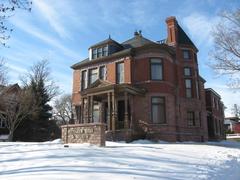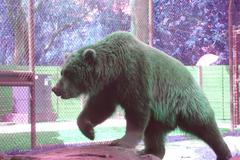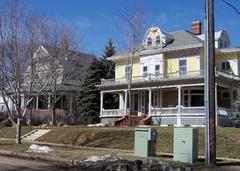Guide to Visiting Good Earth State Park Sioux Falls United States
Date: 17/08/2024
Introduction
Nestled in southeastern South Dakota, Good Earth State Park is an extraordinary blend of natural beauty and profound historical significance. Known historically as Blood Run, the site was a major Native American trading hub, serving as a bustling center of commerce and cultural exchange for the Oneota Tradition Peoples, including the Omaha, Ponca, Ioway, and Otoe tribes. Today, the park offers visitors a unique opportunity to explore a landscape rich in history, archaeological treasures, and diverse ecosystems. With its well-preserved archaeological features, immersive educational exhibits, and scenic trails, Good Earth State Park provides a comprehensive experience for history enthusiasts, nature lovers, and families alike. This guide will provide an in-depth look at the history, visitor information, and tips for making the most of your visit to this remarkable site (South Dakota Game, Fish, and Parks, Plains History).
Table of Contents
- [Introduction](#introductionintroduction)
- [Historical and Cultural Significance](#historical-and-cultural-significancehistorical-and-cultural-significance)
- [Ancient Inhabitants and Settlement](#ancient-inhabitants-and-settlementancient-inhabitants-and-settlement)
- [Oneota Tradition Peoples](#oneota-tradition-peoplesoneota-tradition-peoples)
- [Blood Run: A Trading Hub](#blood-run-a-trading-hubblood-run-a-trading-hub)
- [Archaeological Treasures](#archaeological-treasuresarchaeological-treasures)
- [European Contact and Changes](#european-contact-and-changeseuropean-contact-and-changes)
- [National Historic Landmark and State Park](#national-historic-landmark-and-state-parknational-historic-landmark-and-state-park)
- [Visitor Information](#visitor-informationvisitor-information)
- [Educational and Interpretive Opportunities](#educational-and-interpretive-opportunitieseducational-and-interpretive-opportunities)
- [Interpretive Trails](#interpretive-trailsinterpretive-trails)
- [Preservation and Conservation Efforts](#preservation-and-conservation-effortspreservation-and-conservation-efforts)
- [Modern-Day Significance](#modern-day-significancemodern-day-significance)
- [Nearby Attractions](#nearby-attractionsnearby-attractions)
- [Visitor Tips](#visitor-tipsvisitor-tips)
- [FAQ](#faqfaq)
- [Conclusion](#conclusionconclusion)
Historical and Cultural Significance
Ancient Inhabitants and Settlement
Good Earth State Park, located along the Big Sioux River, provided a fertile floodplain, abundant wildlife, and protection from winds, making it an ideal location for long-term human habitation. The site is one of the oldest in the United States, with evidence of continuous human activity dating back over 8,500 years (South Dakota Game, Fish, and Parks).
Oneota Tradition Peoples
From approximately 1300 to 1700 A.D., the area was primarily inhabited by the Oneota Tradition Peoples, including the Omaha, Ponca, Ioway, and Otoe tribes. These tribes utilized the region for its rich resources and strategic location, which facilitated trade and seasonal ceremonies. The Oneota people were known for their agricultural practices, cultivating crops such as maize, beans, and squash, which they traded along with hides, pelts, and pipestone (catlinite) (South Dakota).
Blood Run: A Trading Hub
The name “Blood Run” is derived from the reddish color of the Big Sioux River, caused by iron ore siltation in the water. This site was a significant trading hub where various tribes gathered to exchange goods. The trading activities at Blood Run were not limited to local tribes; it attracted numerous other tribes from different regions, making it a bustling center of commerce and cultural exchange (Plains History).
Archaeological Treasures
Good Earth State Park is home to numerous archaeological features, including burial mounds, refuse pits, and ancient village sites. These features provide a glimpse into the daily lives and spiritual practices of the Native American peoples who once thrived in this lush landscape. The park’s visitor center and interpretive trails offer educational opportunities for visitors to learn about the site’s archaeological significance (Parks Guidance).
European Contact and Changes
The arrival of European settlers in the 1800s brought significant changes to the region. The settlers began farming the land, which led to the displacement of the native tribes. Despite these changes, the historical and cultural significance of the area was recognized, and efforts were made to preserve its heritage. In the early 1900s, archaeologists began discovering the Oneota settlement, leading to increased interest and preservation efforts (Parks and Wildlife Foundation).
National Historic Landmark and State Park
Good Earth State Park at Blood Run was designated a National Historic Landmark, highlighting its importance as a cultural and historical site. In 2013, it was officially established as a South Dakota state park. The grand opening of the park took place on May 19, 2017, featuring a state-of-the-art visitor center with exhibits that showcase the park’s rich history. The visitor center includes world-class displays, hands-on exhibits, and a 40-person theater that features a film depicting the history of Good Earth (Parks and Wildlife Foundation).
Visitor Information
- Visiting Hours: Good Earth State Park is open year-round. However, between October 1 and April 30, some facilities such as showers and flush toilets may be closed.
- Tickets: Entrance fees apply. Check the official website for current rates.
- Location: The park is located in southeastern South Dakota, along the Big Sioux River.
- Accessibility: The park offers accessible facilities and trails to accommodate all visitors.
Educational and Interpretive Opportunities
The visitor center at Good Earth State Park offers a comprehensive educational experience. It features an 11,000 square foot exhibit hall with displays from Split Rock Studios, including 3D models, a Native American lodge, and hand-painted murals depicting the daily life of the native tribes. The center also includes a theater that showcases a 20-minute film about the history of the park, narrated by a grandfather sharing his story of Good Earth (Parks and Wildlife Foundation).
Interpretive Trails
The park offers over six miles of interpretive trails that meander through rolling prairie land and along the scenic Big Sioux River. These trails are dotted with informational signs that provide insights into the landscapes and environment of the park. The River Lookout Trail and the Bur Oak Trail are particularly popular for their breathtaking views and easy-to-navigate paths. These trails allow visitors to immerse themselves in the natural beauty of the area while learning about its historical significance (Parks Guidance).
Preservation and Conservation Efforts
The South Dakota Parks and Wildlife Foundation has played a crucial role in the preservation and development of Good Earth State Park. The foundation raised over $8 million from private donors and grants to assist with land acquisition and construction development. These efforts have ensured that the park remains a well-preserved site of cultural and historical importance, providing educational and recreational opportunities for future generations (Parks and Wildlife Foundation).
Modern-Day Significance
Today, Good Earth State Park serves as a beautiful reminder of the land’s rich heritage. It offers a unique blend of educational opportunities and picturesque trails, making it a must-visit destination for history buffs, nature lovers, and families alike. The park’s well-preserved landscape and archaeological features provide a profound connection to the past, allowing visitors to explore and appreciate the cultural richness and natural serenity of this significant site (Parks Guidance).
Nearby Attractions
- Falls Park: Located in Sioux Falls, this park features stunning waterfalls and walking trails.
- Great Bear Recreation Park: A popular spot for skiing and hiking.
- Sioux Empire Fair: Held annually in Sioux Falls, offering rides, food, and entertainment.
Visitor Tips
For those planning a visit to Good Earth State Park, here are some useful tips:
- Plan Ahead: Check the current status of facilities, especially if visiting between October and April.
- Day-Use Only: The park is a day-use facility with no camping allowed.
- Special Events: The park offers indoor and outdoor facilities for special events, including meetings, family reunions, and weddings (South Dakota Game, Fish, and Parks).
FAQ
Q: What are the visiting hours for Good Earth State Park?
A: The park is open year-round, but some facilities may be closed between October 1 and April 30.
Q: Are there entrance fees?
A: Yes, entrance fees apply. Check the official website for current rates.
Q: Can I camp at Good Earth State Park?
A: No, the park is a day-use facility with no camping allowed.
Q: Are there accessible facilities?
A: Yes, the park offers accessible facilities and trails.
Conclusion
Good Earth State Park is a site of profound historical and cultural significance, offering visitors a unique opportunity to explore the rich heritage of the native tribes who once thrived in the region. With its well-preserved archaeological features, educational exhibits, and scenic trails, the park provides an enriching experience for all who visit. Don’t miss the chance to immerse yourself in the natural beauty and historical richness of Good Earth State Park. For more information, visit the official website and follow on social media for updates.
Audiala2024
References
- South Dakota Game, Fish, and Parks. (n.d.). Good Earth State Park. Retrieved from https://gfp.sd.gov/parks/detail/good-earth-state-park/
- Plains History. (n.d.). Blood Run. Retrieved from https://plainshistory.org/items/show/27
- Parks and Wildlife Foundation. (n.d.). Projects: Good Earth State Park. Retrieved from https://www.parkswildlifefoundation.org/projects/good-earth-state-park
- South Dakota. (n.d.). State Parks: Good Earth State Park. Retrieved from https://southdakota.com/state-parks/good-earth-state-park/
- Parks Guidance. (n.d.). Good Earth State Park Guide. Retrieved from https://parksguidance.com/good-earth-state-park-guide/
- Experience Sioux Falls. (n.d.). Good Earth State Park at Blood Run. Retrieved from https://www.experiencesiouxfalls.com/listing/good-earth-state-park-at-blood-run
- America’s State Parks. (n.d.). Good Earth State Park. Retrieved from https://www.americasstateparks.org/good-earth-state-park/
- Verdant Traveler. (n.d.). Good Earth State Park at Blood Run. Retrieved from https://verdanttraveler.com/good-earth-state-park-at-blood-run/



